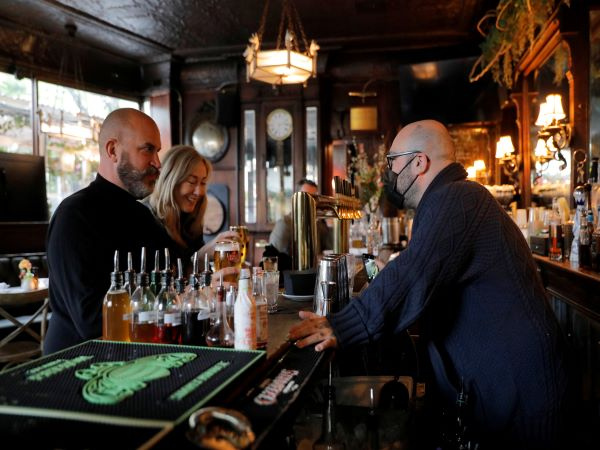New Yorkers take a stool at the bar for first time after a year
Matt Friedlander walked into the White Horse Tavern, grabbed a seat at the polished wooden bar and let out a sigh of relief as he ordered a Budweiser and a glass of bourbon: A major pandemic restriction on drinking in New York City was finally gone.
“Fourteen months since I’ve done this,” the 39-year-old New Yorker said with an air of satisfaction as he sat on a bar stool, his Havanese and Pomeranian mix perched on the seat to his left. “42 inches high and it just feels right,” he said, referring to the standard height of a bar.
During the past year, such a scene would have been impossible at the famed West Village tavern, known as a gathering place for literary figures like Dylan Thomas, Norman Mailer and James Baldwin in the 1950s and 1960s.
But on Monday, New York lifted a ban on bar seating, one of a raft of coronavirus curtailments imposed last March, allowing patrons to resume a hallowed New York drinking tradition. Establishments still have to observe social distancing guidelines of six feet.
Having both completed their second vaccination shots, Anya Paul, 47, and Tim Hermans, 59, came to the White Horse on Monday to grab a quick beer and reclaim a slice of their pre-pandemic life.
“I’m very happy to be able to sit at a bar,” said Hermans. “It’s a great feeling,” said Paul.
By itself, the addition of bar seating is not likely to turn around the fortunes of the city’s beleaguered hospitality industry. More than 1,000 restaurants and bars have closed in New York City since the March 2020 lockdowns, according to industry website Eater New York.
Even so, it is one of a series of steps to loosen restrictions. On Monday New York Governor Andrew Cuomo announced that restaurants, bars and other businesses could reopen at full capacity starting on May 19, which came on top of last week’s pledge to end a midnight curfew on indoor dining on May 31.

Sally, a Havanese Pomeranian mix aged 5, sits at the bar with her owner Matt Friedlander, 39, of New York City at the White Horse Tavern (est. 1880) as restrictions eased on indoor drinking in bars, allowing seating at the bar, during the outbreak of the coronavirus disease (COVID-19) in Manhattan, New York City, New York, U.S., May 3, 2021. REUTERS/Andrew Kelly
For the White House Tavern, which had its liquor license temporarily suspended in July for multiple violations of social distancing guidelines, the changes could add fuel to a recent rebound in revenues as vaccinated customers return to the bar.
“It’s a pretty big deal,” said Zak Snyder, general manager of the pub, estimating that bar seating generated 20% to 30% of its alcohol sales before the March lockdowns.
TWO PANDEMICS IN THE BOOKS
In the East Village neighborhood of Lower Manhattan, McSorley’s Old Ale House had prepared a row of stools for Monday’s change, marking the first time in its 167-year history that patrons were seated – rather than standing as in normal times – at its long wood bar.
Bartender Shane Buggy said they had purchased the stools from a restaurant down the street that had folded. He said he didn’t see the new seats as a long-term solution for a place that thrives on communal tables and crowds around the bar.
“Right now we only have 10 stools where we could have 30 people in this space,” Buggy said as he served ale to a mix of regulars and tourists seated between plexiglass partitions at the bar. “We are looking forward for all of these restrictions to be thrown out so that we can get back to normal.”
Mayor Bill de Blasio says he wants to “fully reopen” New York City by July 1 – a pledge that has encouraged bar owners while also putting a spotlight on operational challenges. Chief among them is a difficulty hiring staff, many of whom have left the city or are collecting unemployment assistance and opting to stay at home, several owners said.
Lon Devitt, 62, said he has been coming to McSorley’s since he was a 17-year old student at a nearby high school and would “run, not walk” with a friend to the bar during 45 minutes breaks and “drink as much as we could” before hustling back to class.

L-R) Tim Hermans, 59 and Anya Paul, 47, are served by general manager Zak Snyder, 35, at the White Horse Tavern (est. 1880) as restrictions eased on indoor drinking in bars, allowing seating at the bar, during the outbreak of the coronavirus disease (COVID-19) in Manhattan, New York City, New York, U.S., May 3, 2021. REUTERS/Andrew Kelly
“This bar has had to adapt tremendously to survive,” said Devitt, noting that the novel coronavirus was the bar’s second pandemic after the catastrophic Spanish Flu of 1918. “What hasn’t changed here is the sense of community.”
Related Articles
Does COVID Cause Depression?
Can I Get COVID More Than Once?
For Sherrie Racines, who had dropped in to McSorley’s to share a few beers with her son, sitting at the bar represented an overdue return to normalcy. Visiting from Florida, she sipped ale on Monday afternoon as Buggy regaled her with tales of the bar’s history, including the time Abraham Lincoln stopped by in 1860, a year before becoming U.S. president.
“It’s almost like the pandemic is behind us,” said Racines, 43. “It makes me feel awesome.”
(Additional reporting by Andrew Kelly in New York; Editing by Frank McGurty and Steve Orlofsky)
Want stories like this delivered straight to your inbox? Stay informed. Stay ahead. Subscribe to InqMORNING

